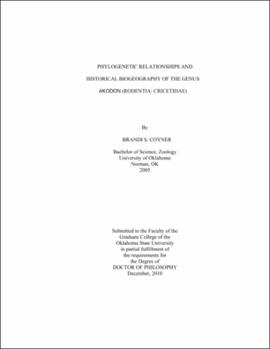| dc.contributor.advisor | Van Den Bussche, Ronald A. | |
| dc.contributor.author | Coyner, Brandi S. | |
| dc.date.accessioned | 2013-11-26T08:28:22Z | |
| dc.date.available | 2013-11-26T08:28:22Z | |
| dc.date.issued | 2010-12 | |
| dc.identifier.uri | https://hdl.handle.net/11244/7028 | |
| dc.description.abstract | Scope and Method of Study: Despite comprising only 12% of the Earth's landmass, South America supports nearly one quarter of all extant species of mammals (Wilson and Reeder 1993). The genus Akodon (Rodentia, Cricetidae) is among the most speciose groups of South American rodents, second only to the genus Oryzomys, where its 46 extant species occur from northern Venezuela to southern Argentina. The genus is organized into four species groups and numerous subgenera and subspecies are recognized. In previous molecular studies of the genus, few taxa and single gene datasets dominate. In this study, 3 genes (cytb, DMP1, and THY) were sequenced and analyzed under maximum parsimony, maximum likelihood, and Bayesian phylogenetic criterion to 1) obtain a well-resolved evolutionary history of Akodon, 2) to evaluate the validity of a number of subspecific taxa and supraspecific groupings, and 3) to evaluate the historical biogeography of the genus. | |
| dc.description.abstract | Findings and Conclusions: Thirty four of the 46 extant species, as well as numerous subspecies, were included here. Of these 46 species, the monophyly of four (A. aerosus, A. mimus, A. mollis, and A. orophilus) are questioned. A. lindberghi is assigned to the cursor group. In the boliviensis group, A. lutescens caenosus currently consists of two species level taxa, both to be elevated to full species. Four taxa, including A. varius, from the varius group are moved to the aerosus group. Additionally two subspecies within the aerosus group (A. aerosus baliolus and A. orophilus orientalis) warrant species recognition. Two additional species level taxa fall within the aerosus group and are unnamed. The redefined varius group is recommened to be referred to as the dolores group. Dates of divergence and relationship of taxa provide the information needed to generate a hypothesis regarding the evolution of the genus. Future efforts in the study of Akodon systematics need to include not only the addition of previously unavailable taxa but also the inclusion of sequence data from multiple genetic markers for all individuals. | |
| dc.format | application/pdf | |
| dc.language | en_US | |
| dc.rights | Copyright is held by the author who has granted the Oklahoma State University Library the non-exclusive right to share this material in its institutional repository. Contact Digital Library Services at lib-dls@okstate.edu or 405-744-9161 for the permission policy on the use, reproduction or distribution of this material. | |
| dc.title | Phylogenetic relationships and historical biogeography of the genus Akodon (Rodentia: Cricetidae) | |
| dc.contributor.committeeMember | Braun, Janet K. | |
| dc.contributor.committeeMember | Hamilton, Meredith J. | |
| dc.contributor.committeeMember | Leslie, David M., Jr. | |
| osu.filename | Coyner_okstate_0664D_11172.pdf | |
| osu.accesstype | Open Access | |
| dc.type.genre | Dissertation | |
| dc.type.material | Text | |
| dc.subject.keywords | biogeography | |
| dc.subject.keywords | cytochrome b | |
| dc.subject.keywords | dentin matrix protein | |
| dc.subject.keywords | akodon | |
| dc.subject.keywords | systematics | |
| dc.subject.keywords | thyrotropin | |
| thesis.degree.discipline | Zoology | |
| thesis.degree.grantor | Oklahoma State University | |
